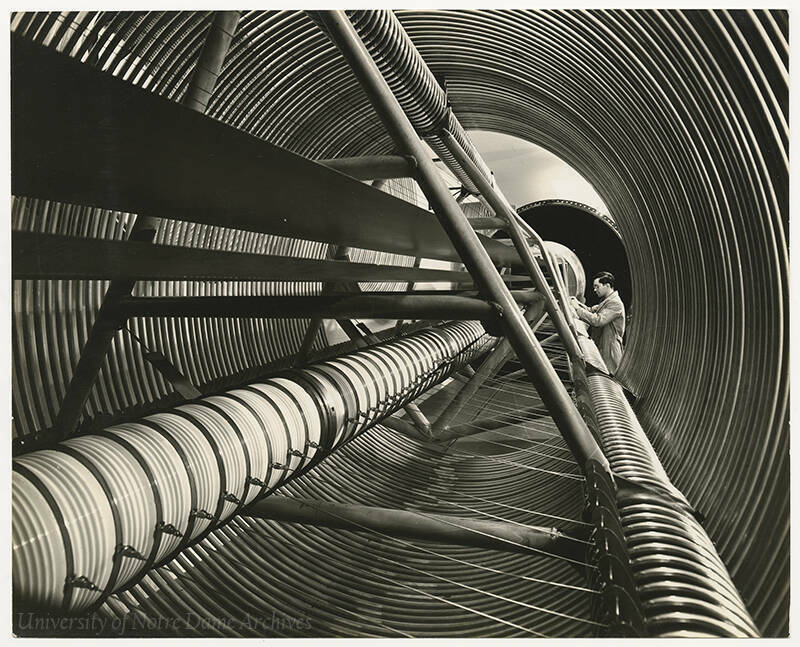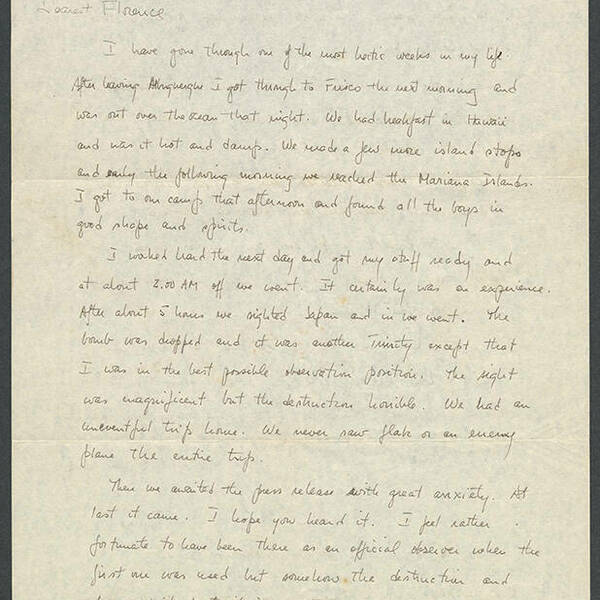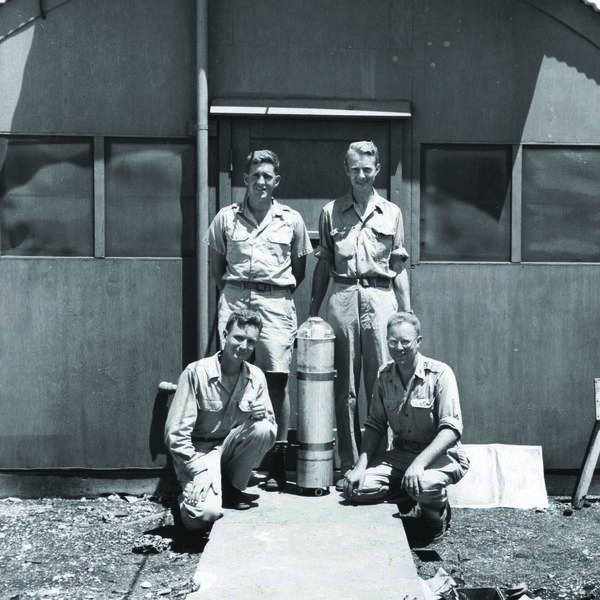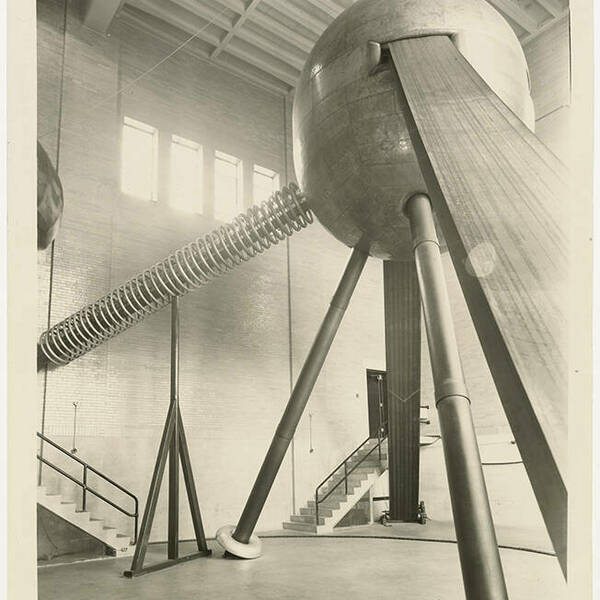 Physics professor George Collins works in the electrostatic particle accelerator in Science Hall in the 1940s. University of Notre Dame Archives
Physics professor George Collins works in the electrostatic particle accelerator in Science Hall in the 1940s. University of Notre Dame Archives
“Are we saying that there’s a chance that when we push that button, we destroy the world?” asks General Leslie Groves, the officer in charge of the Manhattan Project, in Christopher Nolan’s blockbuster biopic on the father of the atomic bomb, J. Robert Oppenheimer.
Groves’ question comes just before the first-ever test of a nuclear weapon. He has learned that the physicists working on the project are aware of a terrifying possibility: that the detonation could start a chain reaction, setting Earth’s atmosphere on fire.
Shrugging off Groves’ concern, Oppenheimer replies that the “chances are near zero.”
“Near zero?” says Groves.
“What do you want from theory alone?” Oppenheimer asks.
“Zero would be nice,” Groves replies.
The Trinity test, as it was known, did not ignite the heavens. It projected a billowing white mushroom cloud tens of thousands of feet high. And there in the air to see it was Notre Dame physicist Bernard Waldman. While Oppenheimer and others witnessed the blast from inside a purpose-built bunker, Waldman analyzed it from a B-29 observation plane.
By the time he found himself high above the New Mexico desert that morning on July 16, 1945, Waldman was no stranger either to “Oppie” or to the risks involved in nuclear research. He encountered both long before he was recruited to help build the ultimate weapon and put an end to World War II.
Waldman was born in New York in 1913 and studied at New York University, where he entered the field of nuclear science in its earliest days. When he came to Notre Dame in 1938, the University had just built its first electrostatic generator at a cost of $900. Working alongside Notre Dame colleague George Collins, Waldman began using the generator to make groundbreaking discoveries. The pair were the first to show that electrons could cause the disintegration of beryllium. They were also the first to document a process called X-ray excitation.
The publications that resulted from these experiments put Notre Dame’s nuclear science program on the map. They drew the attention of many physicists, including Oppenheimer.
The boundary-pushing work by Waldman and Collins also left a literal mark. With safety standards for nuclear research still in development and many risks still unknown, both men developed burns on their hands, arms and legs. In his later years, Waldman would tell his daughter, Tawny Nelb ’75, “Maybe it was good because it forced us to stop working.” The two scientists realized they were being exposed to radiation X-rays. If they hadn’t stopped, Waldman said, “We might have killed ourselves.”
Oppenheimer soon heard about Waldman’s efforts to build a new accelerator — known on campus as the “Atom Smasher” — in the basement of Science Hall, now LaFortune Student Center. He wrote to Waldman sharing equations and findings and suggesting experiments to run using the new accelerator, which at the time was the largest in the world.
In 1942, the United States Army launched the Manhattan Project with Oppenheimer as its director. Scientists at the University of Chicago began coming to Notre Dame by train to use the Atom Smasher to perform top-secret experiments supporting the project. In 1943, Oppenheimer wrote to Waldman asking him to join the project’s team in Los Alamos, New Mexico.
Waldman took a leave of absence from Notre Dame and helped reconstruct an accelerator loaned to the Manhattan Project. He was assigned to Project Alberta, whose task was to sort out the science and engineering of bomb “delivery,” including moving the bomb off site and getting it to the target. Along the way, Waldman also became involved in developing the tools and techniques required to record and analyze the blast.
Following the Trinity test, the atomic bomb was no longer primarily a research project. It was a fully operational weapon. Nolan’s film depicts Oppenheimer looking on with anxiety as the now-proven bombs leave the laboratory site headed for their target halfway around the world.
Because of his experiences with observation and delivery, Waldman was asked to accompany the bomb to its staging area on Tinian Island, 1,500 miles south of Japan. And on August 6, 1945, when Little Boy, a uranium bomb, was dropped on the port city of Hiroshima, Waldman was there, observing the blast from a plane called Necessary Evil.
Oppenheimer famously recalled that, at the Trinity test, he thought of a line from the Bhagavad Gita, a Hindu scripture — the moment when “Vishnu is trying to persuade the prince that he should do his duty, and to impress him takes on his multiarmed form and says, ‘Now I am become Death, the destroyer of worlds.’ I suppose we all thought that one way or another.”
In fact, Waldman’s reaction was different. His plane had to deal with poor weather and delays. He saw the test from several miles away. But over Hiroshima, he was seeing the bomb not just as an experiment but as an actual instrument of death and destruction — and he was seeing it from above. Initially wearing welder’s glasses to protect his eyes from the blast, Waldman removed them and was able to look for about two minutes into the devastation before losing visibility.
Although Waldman shared little of Oppenheimer’s penchant for philosophizing and literary quotation, his reaction this time was not so different: a similar sense of duty standing side by side with the awful weight of the bomb’s devastation.
In a letter to his wife, Florence, written upon his return to Tinian and after hearing President Harry S Truman’s announcement of a blast with the explosive energy of 20,000 tons of TNT, he wrote:
The sight was magnificent but the destruction horrible. . . . I feel rather fortunate to have been there as an official observer when the first one was used but somehow the destruction and horror of it is terrifying. It is a most fiendish device. I hope we do not have to use [it] again.
After the war, Oppenheimer used his newfound fame to try and shape the development of U.S. nuclear policy, though he was eventually sidelined when the so-called second Red Scare threw suspicions on his left-wing political interests.
Waldman, as an eyewitness to the first use of an atomic weapon, answered his fair share of questions from the press, too. When asked, he would admit anxieties about the development of the nuclear program.
“You only have to see what a horrible thing it is,” he said. “We who have seen the bomb and worked with it, are scared, really scared.” Waldman supported international scientific collaboration on nuclear energy and said that civilians rather than the military should control the U.S. atomic program, telling The Notre Dame Scholastic in 1946, “If we have military control, scientists will be driven from the field entirely.”
Mostly, though, Waldman opted for a quieter life. Rather than spending his time advocating for specific policies, he focused on developing the research — and the researchers — who could make nuclear science a benefit to humanity.
Weeks after his return from Tinian, Waldman took up his old post, returning to Notre Dame for the fall semester of 1945. He began directing the nuclear physics laboratory and launched efforts to build another, still larger accelerator that was completed in 1955. He was dean of the College of Science from 1967 until he retired in 1979. Apart from a few years away in the early 1960s to direct the Midwestern Universities Research Association, he had stayed at Notre Dame until his retirement, which the University marked with a “Waldman Festival” recognizing his contributions.
Waldman died November 12, 1986. His simple gravestone lies in a quiet corner of Cedar Grove Cemetery.
Brett Beasley is a writer and editorial program manager for Notre Dame Research.



